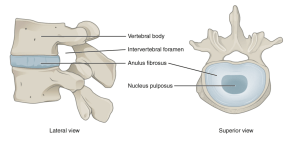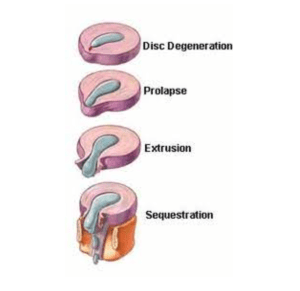I. Introduction
A. Explanation of slipped discs:
A slipped disc, also known as a herniated or bulging disc, refers to a condition in which a spinal disc’s soft inner material (nucleus pulposus) pushes through a tear in the outer layer (annulus fibrosus). This can cause pain, numbness, or weakness in the back, arms, legs, and neck.

B. Importance of proper treatment:
Slipped discs can significantly impact a person’s quality of life, making it an excellent idea to receive proper treatment. Appropriate treatment can will help improve your chances of recovery. Conversely, neglecting treatment can lead to chronic pain, discomfort, and decreased mobility and functionality. However, I must mention that discs can and do often heal without any treatment. At Move Freely, we recommend early intervention with physiotherapy as soon as you notice symptoms.
II. What is the best treatment for slipped discs?
A. Non-surgical options:
IDD (Intervertebral Differential Dynamics) therapy is a non-surgical treatment option to help heal herniated discs. This therapy uses a computer-controlled traction system to apply gentle, repetitive movements or oscillations to the affected area. Precise angles target the specific herniated disc, helping to reduce pressure on the affected nerve and promoting healing.
The physiological effect of IDD therapy is multi-faceted. It helps to:
- Relieve pressure on the affected nerve: By reducing pressure on the nerve, IDD therapy helps to alleviate the pain, numbness, and tingling that are often associated with herniated discs.
- Increase circulation: IDD therapy helps to improve circulation in the affected area, providing oxygen and nutrients to the disc and promoting healing.
- Stimulate the production of natural healing agents: IDD therapy helps stimulate the production of biological healing agents necessary for the healing process.
- Improve joint function: IDD therapy helps to improve joint function by reducing stiffness and increasing the range of motion. This can help to reduce pain and improve overall function.
IDD therapy is a safe and effective option for individuals looking for a non-surgical way to manage the symptoms associated with herniated discs. It is performed by trained therapists who use a computer-controlled system to precisely target the affected area, providing a personalised treatment plan to help achieve optimal healing and relief.
Physiotherapy and exercise to help with Disc issues:
A. Physiotherapy and exercise:
Physiotherapy and exercise help manage symptoms and improve functionality when recovering from a slipped disc. At Move Freely, our physiotherapists develop a personalised exercise rehabilitation plan to target specific muscle imbalances and improve your strength, flexibility, and stability so that you are moving as well as possible and have the best chance of not suffering from back pain in the future.
B. Surgical options:
Many people who have a slipped disc are often considering surgery. In some cases, surgery is necessary to treat a slipped disc. However, this should only be done as a last resort or in more complex situations, like if you have cauda equine syndrome. Surgical options include:
Microdiscectomy:
Microdiscectomy is a minimally invasive surgical procedure that involves removing a portion of the herniated disc to relieve pressure on the spinal nerve.
Laminotomy:
Laminotomy is a surgical procedure that involves removing a portion of the lamina, the bony roof of the spinal canal, to relieve pressure on the spinal nerve. This procedure may be performed with a microdiscectomy or other spinal surgery.
III. Who treats slipped discs?
A. Orthopedic Surgeon:
An orthopaedic surgeon is a medical doctor who specialises in diagnosing and treating musculoskeletal conditions, including slipped discs.
B. Neurosurgeon:
A neurosurgeon is a medical doctor who specialises in diagnosing and treating conditions involving neurological issues, including slipped discs. Neurosurgeons can perform surgery to treat a slipped disc. In addition, neurosurgeons and orthopaedic surgeons can advise on the best treatment options for people suffering from slipped discs. In many cases, a good surgeon will not recommend surgery and may refer for a non-invasive treatment option.
C. Physiotherapists:
Physiotherapists are healthcare professional who specialises in physical rehabilitation. They can develop a personalised exercise plan to help individuals manage symptoms and improve functionality following a slipped disc. Physiotherapists at our Edinburgh clinic have many skills to help people recover from a slipped disc. We combine IDD therapy, rehabilitation exercises, Deep tissue laser therapy, tamars spinal mobilisation, and sports massage and provide advice on what’s best to do and what’s not good to do when you have a slipped disc.
D. Chiropractor:
A chiropractor specialises in treating spinal conditions, including slipped discs. They can provide non-invasive, drug-free treatments such as spinal adjustments and manual therapy to relieve pain and improve function. Many people find chiropractic treatment helpful for back pain. Still, spinal manipulation is not usually a good treatment to help discs heal. It may provide some short-term relief, but you will be lucky if you get more than that.
IV. Can a physiotherapist fix a slipped disc?
A. Importance of physiotherapy:
Physiotherapy plays an essential role in the management of slipped discs. As mentioned earlier, physiotherapy can relieve pain and improve function, which will help reduce the risk of future problems. However, not all physiotherapy is created equal. A good physiotherapist will assess your disc issue and current movement stages. Before designing your treatment plan, they should also consider your wants and needs so that the program is specific to you.
B. How physiotherapy helps with slipped discs:
Physiotherapy can help individuals with slipped discs by addressing specific muscle imbalances and improving strength, flexibility, and stability. A physiotherapist can also provide manual therapy to relieve pain and improve mobility. At Move Freely, we combine this with IDD therapy. The IDD Therapy will help the slipped disc heal as the manual therapy and rehabilitation exercises improve the patient’s function.
C. Personalised exercise rehabilitation plan:
Personalised exercise rehabilitation plans target muscle imbalances and improve strength, flexibility, and stability. This plan may include exercises and stretches to help manage symptoms and improve functionality. The most improtant part of the plan is to make it specific to the needs and wants of each patient. For example, a 70-year-old who needs to go up and down their stairs again and wants to play with their grandchildren needs exercises that will replicate these tasks. A 30-year-old rugby player who wants to return to playing rugby will need a different set of exercises with more load. It will progress to include heavy lifting and running as part of the plan. Conversely, the 70-year-old will not need to be able to sprint or squat 100kg.
V. Does a slipped disc ever fully heal?
A. Factors affecting healing:
The healing process of a slipped disc can vary depending on several factors, including age, overall health, and the severity of the injury. In many cases, slipped discs heal independently, while medical intervention may be necessary for others. It takes about 18 months for the majority of slipped discs to heal. Therefore, it is undoubtedly not the lifelong issue many medical professionals will have you believe. Interestingly research has shown that the larger the herniation, the better chance you have of healing the disc. This study from 2005 reported, “The rate of spontaneous regression was found to be 96% for disc sequestration, 70% for disc extrusion, 41% for disc protrusion, and 13% for disc bulging. The complete resolution rate of disc herniation was 43% for sequestrated discs and 15% for extruded discs.” (1)

B. Long-term management of slipped discs:
Sometimes, a slipped disc may not fully heal. Long-term management may be necessary to manage symptoms and improve functionality. This may include ongoing physical therapy and exercise, medication to manage pain, or non-invasive decompression therapy (IDD) to alleviate pressure on the affected nerve.
VI. Diagnosing a slipped disc
A. Need for an MRI:
An MRI is a standard diagnostic tool used to diagnose a slipped disc. This imaging test provides detailed images of the spinal cord and surrounding tissues, allowing doctors to see if a disc has slipped or ruptured. Of course, a physiotherapist will have a good idea if you have a slipped disc before referring you for an MRI. Still, the MRI will offer complete clarity on what exactly is going on with the disc, the type of slipped disc, and if it is compressing the nerve root or causing any other complications.
B. Other imaging options:
In addition to an MRI, other imaging options for diagnosing a slipped disc may include a CT scan, X-rays, or nerve conduction studies. The appropriate imaging test will depend on the individual’s specific case and the suspected cause of the slipped disc.
VII. When is a slipped disc considered serious?
A. Symptoms indicating a serious slipped disc:
Symptoms of a severe slipped disc, called red flags, may include severe and persistent pain, numbness or tingling in both arms or legs simultaneously, weakness in both limbs limb, and difficulty with bladder or bowel control. If you are experiencing any of these symptoms, it is crucial to seek immediate medical attention.
B. Importance of prompt medical attention:
A severe slipped disc accompanied by one or more red flags above can result in long-term nerve damage if left untreated. Prompt medical attention and proper treatment can help to prevent further damage and improve your chances of recovery.
VIII. What makes a slipped disc worse?
A. Making a slipped disc worse:
Usually, the biggest issue with making slipped discs worse is not moving enough, sitting or lying for too long in the same position. The discs need movement to heal. Walking and swimming can help the pump action, bringing more nutrients to the disc and allowing it to heal faster.
B. Importance of managing underlying conditions:
Conditions such as obesity, arthritis, and spinal stenosis can stress your lower back and increase your risk of developing a slipped disc. However, managing these conditions through proper diet, exercise, and medication can help prevent a slipped disc from worsening.
Final thoughts on slipped disc treatment near me:
It’s important to remember that slipped discs can cause severe discomfort and significantly hinder daily life. However, with proper treatment and management, many people can find relief and return to normal activities. Whether you choose non-surgical options like IDD therapy and physiotherapy or surgical intervention, working closely with a healthcare professional who can provide a personalised treatment plan to meet your individual needs is crucial.
When seeking slipped disc treatment near you, it’s essential to do your research to find a good provider who is experienced and knowledgeable in treating these conditions. Whether you choose an orthopaedic surgeon, neurosurgeon, physical therapist, or chiropractor, discuss your symptoms and concerns and ask about their approach to treatment.
By taking a proactive approach to your slipped disc treatment, you can work towards finding the relief you need and getting back to the activities you love.
Referencing
1- Chiu, C. C., Chuang, T. Y., Chang, K. H., Wu, C. H., Lin, P. W., & Hsu, W. Y. (2015). The probability of spontaneous regression of lumbar herniated disc: a systematic review. Clinical Rehabilitation, 29(2), 184-195. https://pubmed.ncbi.nlm.nih.gov/25009200/